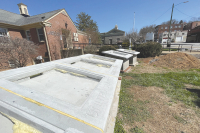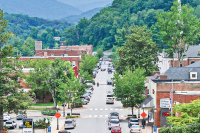Reaching out: Hispanic market looms large for WNC businesses
By Julia Merchant • Staff Writer
Hispanic culture has infused nearly every aspect of American life — from restaurants to bilingual education, its influence is impossible to ignore. Yet, much to their detriment, many businesses in Western North Carolina are ignoring the growing influence and prosperity of the Hispanic community.
It is becoming increasingly evident that Hispanics are making their biggest impact not on food or social services but on the economy. According to a 2006 study released by University of Chapel Hill’s respected Kenan-Flagler Institute, Hispanics filled one in three new jobs created in North Carolina between 1995 and 2005, with significant concentrations in the construction industry. After taxes, this translated into $8.3 billion in income.
“The reality is that any business in Western North Carolina is right now turning down an enormous amount of business or not taking advantage of a huge market, simply because they don’t have somebody that speaks Spanish,” said Bob McCarson, publisher of La Voz Independiente, a Spanish language newspaper based in Hendersonville.
Cultivating customers
Figuring out ways to market services to the Hispanic community can easily stump businesses. Lack of advertising mediums don’t help — ‘La Voz Independiente is the only Spanish-language newspaper in Western North Carolina. According to McCarson, who works extensively with the Hispanic community in WNC, Hispanics often forgo subscribing to cable.
“I think there is a great misconception in the Anglo community that they can reach the Hispanic market through traditional means. The reality is that studies show that they don’t read English-language newspapers and there is no Spanish language television or radio station (in the region),” he said.
Since cable television is expensive and only carries the two Spanish networks of Univision and Telemundo, McCarson said many Hispanics don’t even bother. Advertising on cable can turn into a waste of dollars, and only reaches “a drop in the bucket compared to the number of people who are really here,” McCarson said.
A Spanish-language newspaper like La Voz is a successful way to reach the Hispanic base of customers in Haywood County, according to La Mexicanita owner Jose Molina. La Mexicanita is a retail store located in Waynesville that sells everything from clothes to phone cards to food. Molina said many of his customers find out about services through the paper since the ads are printed in a language they can understand. However, La Voz no longer distributes its paper in Haywood County. Molina is forced to drive to Hendersonville or Asheville to pick up copies. His willingness to do so is a testament to the dire need for some kind of medium that will communicate to the Hispanic population of western North Carolina.
Alternative methods of advertising that McCarson suggested could reach Hispanics are church bulletins — local Catholic churches, which cater to the majority of the Hispanic community, print advertisements on the back of their weekly bulletins. Molina’s wife Patricia said that her community does pay attention to those advertisements. Additionally, advertising at festivals, community activities or local Hispanic stores are all good ways to reach Hispanics, McCarson said.
Following through
When a company places an advertisement in Spanish in an attempt to reach the Hispanic population, they don’t always realize the necessary measures they must have in place to help those who respond to the ad — namely, someone who speaks Spanish.
“We’ve had this happen, and people are shocked when they get phone calls and those people don’t speak English. Our readers assume that if you have an ad, you have someone that speaks Spanish,” McCarson said.
Often, though, having someone bilingual on staff is a luxury businesses can’t afford. Patricia Molina said through a translator that the Hispanic community faces language barriers in almost every local industry. Besides the First Citizen’s Bank and Sun Trust Bank in Canton, it’s difficult to find a bank with a Spanish-speaking representative. She is normally able to navigate grocery stores and clothing shops on her own, but when purchasing a car or a cell phone, forget it — Molina says she and others in her community have to find a translator willing to go with them to make purchases. All in all, Molina said having at least one Spanish-speaker at local businesses would bring in more clients and make it much easier for the Hispanic community as a whole.
Word of mouth
When a business does have a bilingual representative on staff, and makes extra effort to help their Spanish-speaking clients, the Hispanic population takes notice — and tells their friends. At Macon Bank in Franklin, having a fluent Spanish-speaking customer representative on staff who can guide Hispanic clients through the process of opening checking accounts and taking out loans has made the bank the go-to place for the local Hispanic community.
“Word of mouth is huge for us, and we’ve found that a lot of (Hispanic clients) have said, ‘Go see him,’ and pulled other people they know through church and community groups. They’re able to refer their family and friends over to us, and that makes them comfortable,” said Macon Bank Marketing Director Patrick Moore.
John Barrett, owner of Barrett Motors in Waynesville, said word of mouth has also made his business popular with the Hispanic community. Treating clientele with respect, being straightforward and having a long-time employee who took Spanish classes in order to better communicate with customers has helped Barrett Motors develop a sizeable Hispanic customer base, which today accounts for more than 10 percent of his business.
McCarson is adamant that having someone on staff who speaks Spanish is imperative for the automotive industry, “because for most of (the Hispanic population), their biggest investment is their car.”
Any business, though, can benefit immensely from having a Spanish-speaking person on staff. For larger corporations, it’s becoming mandatory — and they’re scrambling to keep up with demands.
Verizon Wireless, which has the largest cell phone network in Western North Carolina, attempts to have two bilingual staff members working in each of its stores, according to spokesman Carly Culberson.
“We know that (the Hispanic population) is growing and ... we are getting more and more anxious to find folks and get them interested in working with Verizon Wireless,” she said.
That’s a lofty goal and one that the company falls short of, at least in Waynesville, where the one bilingual representative was on vacation. Verizon does, however, provide a customer service line where Spanish-speaking representatives can be reached, and has a Spanish language version of its Web site.
How much to gain?
A crucial question still remains — how much do businesses truly stand to gain from marketing to and providing services for Hispanic clientele? After all, the Hispanic populations of Haywood, Jackson, Swain and Macon all hover around 2 percent, according to a 2005 update of the U.S. Census. That’s a relatively small portion of the overall population.
However, evidence points to the fact that both the Hispanic population and the buying power wielded by that demographic are increasing.
McCarson points out that “Mexicans in particular (who he says account for 85 percent of the state’s Hispanic population) have a reputation for being consumers and using their disposable income to buy goods.”
According to McCarson, Hispanics spend anywhere from $300 to $500 more a month on groceries than Caucasians do — they have larger families and prepare more meals from scratch. Additionally, they are big consumers in the automotive, clothing, and cellular phone industries, he said.
At Macon Bank, Moore observes the growing buying power of the Hispanic population on a regular basis.
“More and more of that population are starting to seriously look at residences. Many of them are making good money and they’re purchasing like anyone else,” he said.
Moore’s bank routinely helps its Hispanic customers with vehicle purchases, and he has seen an increasing number of Hispanic clientele taking out small loans.
Western Carolina University economics professor Dr. James Smith — who pointed out that North Carolina has had the largest increase in Hispanics over the last decade of any state — had words of warning for businesses in the region: “You ignore any segment of your customer base at your own peril.”
And with the average income of Hispanics in the state hovering around $32,000, according to the Kenan-Flagler study, the growing Hispanic community is one population segment that is becoming increasingly disadvantageous to ignore.





